 | |
Deaf Dog Education Action Fund |
| Home | | | FAQs | | | | | Resources | | | Rescue | | | You Can Help |
Teaching Hand Signs
Understanding your dog and knowing how to control him, develop his potentials, and resolve behavior problems, emotional conflicts and frustrations are no less essential than love and respect.
- Michael W. Fox
- Training for Deaf Dogs
- Do You Need A Trainer?
- What to Use for Hand Signs
- Training With Food
- Teaching A "Good Dog" Sign
- Teaching "Watch Me"
- Teaching "No"
- Teaching a "Release" Word
- Teaching your dog to be Gentle
- Teaching "Sit"
- Teaching "Down"
- Teaching "Stand"
- Teaching "Stay"
- Teaching "Leave It"
- Teaching "Come" & "C'mere"
- Teaching "Go" and "Move"
- Teaching to "Walk Nice"
- Going Further (Tricks, Vocabulary)
Training for Deaf Dogs
 Training a deaf dog is really not so very different from training a hearing one, you just "talk" in a different language. It doesn't require any more time, effort, or necessarily different methods, just different cues. Hearing dogs learn the meaning of words through repetition. Deaf dogs learn the same way. Dogs do not understand English (or any other language). Because we depend so much on speech, we tend to think that dogs communicate that way too, when in fact, they don't. When two strange dogs meet, there is very little sound. They tell each other almost everything through body language first, then by scent. Barking, growling, or whining is an additional form of communication, not the primary one. Dogs who compete for Obedience titles are required to learn hand signs to receive their UD (Utility Dog) title, and many other working dogs use either signs or body language cues to do their work (many trainers will tell people to teach their dog voice commands first, and make sure they understand them, before moving on to hand signs, since signals are much easier for any dog to learn). So while some allowances must be made, teaching hand signals to a deaf dog is really not a big deal.
Training a deaf dog is really not so very different from training a hearing one, you just "talk" in a different language. It doesn't require any more time, effort, or necessarily different methods, just different cues. Hearing dogs learn the meaning of words through repetition. Deaf dogs learn the same way. Dogs do not understand English (or any other language). Because we depend so much on speech, we tend to think that dogs communicate that way too, when in fact, they don't. When two strange dogs meet, there is very little sound. They tell each other almost everything through body language first, then by scent. Barking, growling, or whining is an additional form of communication, not the primary one. Dogs who compete for Obedience titles are required to learn hand signs to receive their UD (Utility Dog) title, and many other working dogs use either signs or body language cues to do their work (many trainers will tell people to teach their dog voice commands first, and make sure they understand them, before moving on to hand signs, since signals are much easier for any dog to learn). So while some allowances must be made, teaching hand signals to a deaf dog is really not a big deal.
Do You Need A Trainer?
I can train any dog in five minutes. It's training the owner that takes longer.
- Barbara Woodhouse
 It's not necessary to hire a trainer, but it can be helpful. While it is always possible to train your dog with no outside help, sometimes a trainer can point out another way to teach that might work better with your dog, or may be able to help solve a particular behavioral problem that you are having. Another benefit is that your dog learns to socialize (to a certain extent), and to "listen" to you, even in a room full of distractions. Remember though, that class time is when you learn how to teach your dog. Your dog will learn at home (and then show off in class the following week). We have a list of trainers on our trainers page (you may also want to check the links on how to choose a trainer). While you may not always be able to find a trainer with deaf dog experience, you should be able to find one who is open-minded enough to want you in their class. It is also a good idea to read as much on dog training and behavior as you can (see our Recommended Reading page for suggestions), as the more you know, the better trainer you will be.
It's not necessary to hire a trainer, but it can be helpful. While it is always possible to train your dog with no outside help, sometimes a trainer can point out another way to teach that might work better with your dog, or may be able to help solve a particular behavioral problem that you are having. Another benefit is that your dog learns to socialize (to a certain extent), and to "listen" to you, even in a room full of distractions. Remember though, that class time is when you learn how to teach your dog. Your dog will learn at home (and then show off in class the following week). We have a list of trainers on our trainers page (you may also want to check the links on how to choose a trainer). While you may not always be able to find a trainer with deaf dog experience, you should be able to find one who is open-minded enough to want you in their class. It is also a good idea to read as much on dog training and behavior as you can (see our Recommended Reading page for suggestions), as the more you know, the better trainer you will be.
What to Use for Hand Signs
A dog can express more with his tail in minutes, than his owner can express with his tongue in hours.
- Author Unknown
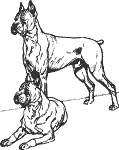 First of all, there are no "wrong" hand signs, you can use whatever you feel most comfortable with, as long as you are consistent. There are a few basic obedience signs, but not enough to truly communicate with your dog. The advantage to using these is that most people who have trained a dog will be able to give your dog basic commands. Some people use ASL (American Sign Language - see our Websites page in the Resources area for on-line references, or check our Books on Deaf Dogs for dictionaries), just as they would for a deaf person. This can be an advantage because anyone who knows ASL will be able to talk to your dog. Some people use modified ASL, so that they can hold a leash in one hand and talk to the dog with the other. Some people make up all their signs (you will probably still want an ASL dictionary, as it can be a challenge to invent signs with nothing to go on). Most people end up using a combination (i.e. obedience signs, and then one handed ASL). Anything you choose is "right" for you and your dog. The examples and ASL suggestions given on this page are just that, examples. Feel free to use (or not) anything given.
First of all, there are no "wrong" hand signs, you can use whatever you feel most comfortable with, as long as you are consistent. There are a few basic obedience signs, but not enough to truly communicate with your dog. The advantage to using these is that most people who have trained a dog will be able to give your dog basic commands. Some people use ASL (American Sign Language - see our Websites page in the Resources area for on-line references, or check our Books on Deaf Dogs for dictionaries), just as they would for a deaf person. This can be an advantage because anyone who knows ASL will be able to talk to your dog. Some people use modified ASL, so that they can hold a leash in one hand and talk to the dog with the other. Some people make up all their signs (you will probably still want an ASL dictionary, as it can be a challenge to invent signs with nothing to go on). Most people end up using a combination (i.e. obedience signs, and then one handed ASL). Anything you choose is "right" for you and your dog. The examples and ASL suggestions given on this page are just that, examples. Feel free to use (or not) anything given.
Training With Food
... she cocks her head to one side, fixes one with her luminous almond eyes, furrows her brow into puzzlement and seems to say, "I would understand you thoroughly if you could speak more clearly. And incidentally, have you got a biscuit on you?"
- Alec Guinness
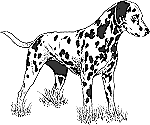 In order to teach any dog anything, you need a way to "reward" the correct behavior. Since you can't use your voice (as you would with a hearing dog), some other reward is needed. Food treats are the easiest, and work with most dogs (many trainers recommend training hearing dogs with food as well). If yours happens to not respond to treats, a toy (such as a ball or other favorite item) may work instead. You will just need to be creative.
In order to teach any dog anything, you need a way to "reward" the correct behavior. Since you can't use your voice (as you would with a hearing dog), some other reward is needed. Food treats are the easiest, and work with most dogs (many trainers recommend training hearing dogs with food as well). If yours happens to not respond to treats, a toy (such as a ball or other favorite item) may work instead. You will just need to be creative.
Training treats work the best when it is something that the dog really wants (pay attention to what your dog likes, there's no reason to "work" for something that isn't motivating). The treats should be small, and quick to eat. You lose momentum when the dog has to chew up and swallow their treat. Soft and "smelly" ones are usually favorites. Try using things like hot dogs, cheese, cut up leftovers (like chicken), or something similar. It isn't necessary to buy treats at the store, your dog won't know she's eating "people" food (and often the pre-made treats contain things that aren't very good for your dog).
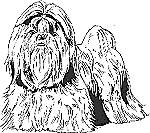 Sometimes people are concerned that their dog will get fat if they use treats. If you are careful, and take sensible precautions, this won't be a problem. If you are doing a lot of training, don't feed the dog so much that day. Substitute other, lower calorie goodies, such as fruit (really, some dogs like fruit!), carrots, or even a breakfast cereal (such as Cheerios). Be creative and see what your dog likes. (Just remember not to get carried away, even something low calorie can be overdone.) Make sure that your dog is getting enough exercise (always important). You can also try using some of your dogs regular kibble as a reward, but you should always use the "good" stuff when teaching something new, or when you get a particularly good response to a known command.
Sometimes people are concerned that their dog will get fat if they use treats. If you are careful, and take sensible precautions, this won't be a problem. If you are doing a lot of training, don't feed the dog so much that day. Substitute other, lower calorie goodies, such as fruit (really, some dogs like fruit!), carrots, or even a breakfast cereal (such as Cheerios). Be creative and see what your dog likes. (Just remember not to get carried away, even something low calorie can be overdone.) Make sure that your dog is getting enough exercise (always important). You can also try using some of your dogs regular kibble as a reward, but you should always use the "good" stuff when teaching something new, or when you get a particularly good response to a known command.
Often people are concerned that their dog will not perform unless there is food in their hand. Food is used as a "lure" to get the desired behavior, and as a "reward" for the correct behavior. It should never be used as a "bribe" once the dog knows the correct response (in other words, don't hold a treat in front of your dog and then sign "sit"). To prevent the dog from becoming dependent on treats, they should be "faded" (once the dog completely knows what to do). (For more details, please read Suzanne Clothier's article on Rewards, Lures & Bribes.)
Basic Guidelines
- Don't try to train your dog right after he eats. If he's full, he won't be as interested.
- Don't train when either you or your dog are sick or upset. You will only make each other unhappier.
- Try to keep your training sessions short and often. Ideally, 5 to 10 minutes, 3 times a day.
- Always end on a positive note. If you are trying something new, and your dog just isn't getting it, go back to something he knows well.
- When the dog is first learning, reward every time he performs the behavior.
- When the dog gets it completely right, big reward! This is called a "jackpot" and should be a fair sized handful of whatever treat you have. Lots of praise, and quit training for that session.
- Don't try to rush your dog. All dogs learn at different rates, so go at your dog's pace.
- Start training where there are no distractions, and gradually build up the difficulty. For instance, go from inside, to back yard, to front yard, to quiet street, to busy sidewalk, to crowded dog show. Your dog needs to learn that he can do what you ask, no matter what else is happening around him.
Turning the Lure into a Reward
- Instead of having the treat visible, hold it behind your back, or put it in your pocket.
- After he has thoroughly learned the command, reward only the best performances (just be careful not to expect more than he is capable of). Substitute a signed "good dog" for so-so performances.
- As he gets better, ask him to do more than one thing for his treat.
- Mix in non-food rewards, such as petting or toys (as long as your dog likes those things - petting is not a reward if your dog doesn't like it).
- Keep treats hidden in dog proof places around the house. Your dog will never know when you will decide that he should get a treat!
- With enough practice, responses will become automatic, and won't require treats (except on special occasions, just for fun)
The following training suggestions are just that, suggestions. There are many, many ways to train a dog, and these are only here as a starting point.
Return to indexTeaching A "Good Dog" Sign
The first thing to teach your dog is a sign for "correct" or "good dog!" You can use the ASL word for "Good," or a "thumbs up" or anything else that feels comfortable to you. To teach it, sit with your dog and a handful or so of really tasty treats. Use your "good" sign, and give the dog a treat. Repeat this several (approximately 3 to 10) times. Then give your sign and see what happens. If she looks at you as if to say "well, where's my treat?", she understands! Give her the treat.
Return to indexTeaching "Watch Me"
There are two theories to teaching "watch me." One is to teach it as a habit (something the dog should do a lot, especially if he doesn't know what else to do), and the other is to teach it as a command (when given the sign).
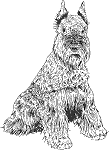 To teach it as a habit, you start out by taking a treat, putting it up to the dog's nose, bringing it up to your nose, signing "good," and then giving the treat to the dog. The idea is for your dog to look you in the eye. Practice this for a few days. Then go to the next step, and hold the treat away from you (start out a foot or so from your face). Your dog will probably look at the treat. Wait until your dog gets impatient, and looks at you to say "well, where's my treat?" Quickly sign "good dog" and give him the treat. At first, all you will get is a quick glance, but you can slowly build up the time that your dog will look you in the eye. You should also hold the treat in different places (use the other hand, hold it in front of you, and at full arm's length). Practice holding the treat behind your back as well. You want the dog to learn that no matter where the treat is, the only way to get it is to look at you.
To teach it as a habit, you start out by taking a treat, putting it up to the dog's nose, bringing it up to your nose, signing "good," and then giving the treat to the dog. The idea is for your dog to look you in the eye. Practice this for a few days. Then go to the next step, and hold the treat away from you (start out a foot or so from your face). Your dog will probably look at the treat. Wait until your dog gets impatient, and looks at you to say "well, where's my treat?" Quickly sign "good dog" and give him the treat. At first, all you will get is a quick glance, but you can slowly build up the time that your dog will look you in the eye. You should also hold the treat in different places (use the other hand, hold it in front of you, and at full arm's length). Practice holding the treat behind your back as well. You want the dog to learn that no matter where the treat is, the only way to get it is to look at you.
Teaching "watch me" as a command is very similar, except that you sign "Look" to the dog before trying to get them to look at you. Some people initially teach this by putting food in their mouth and then spitting it out at the dog when he looks at you. You should still follow up by teaching your dog to watch even when the food is held elsewhere.
No matter which method you end up using to teach your dog, it is important to randomly reward eye contact whenever you notice it (remember those treats you stashed around the house?) Just smile, sign "good dog" and pull one out. Your dog will watch you more often! (For more tips on getting your dog's attention when he isn't looking at you, see our Training page.)
Return to indexTeaching "No"
Hardly any animal can look as deeply disappointed as a dog to whom one says "no."
- Jeffrey Maussaieff Masson
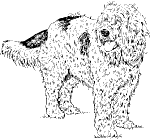 "No" is probably the most overused word in dog training. It is better to tell the dog something that she can do, rather than just to yell "no" all the time. For instance, if your dog jumps on you when you get home, what does telling her "no" do? Well, she knows that you aren't happy when she jumps, but she doesn't know what to do instead. So she tries something else and gets another "no." This could go on for quite a while as she tries to figure out what the proper greeting behavior is (and your dog could get the idea that you don't like her very much). It is far easier (on both of you), to tell her to "sit" and skip the "no" part altogether. You need to tell the dog what is "right," and "constructive criticism" will get you there a lot quicker.
"No" is probably the most overused word in dog training. It is better to tell the dog something that she can do, rather than just to yell "no" all the time. For instance, if your dog jumps on you when you get home, what does telling her "no" do? Well, she knows that you aren't happy when she jumps, but she doesn't know what to do instead. So she tries something else and gets another "no." This could go on for quite a while as she tries to figure out what the proper greeting behavior is (and your dog could get the idea that you don't like her very much). It is far easier (on both of you), to tell her to "sit" and skip the "no" part altogether. You need to tell the dog what is "right," and "constructive criticism" will get you there a lot quicker.
So teaching no is a little less precise, since all that it really means is "stop." Most people end up teaching at least 2 versions of no, one for minor problems, and one for big problems. The first one is for "No, that's not what I want," and just means to cut it out, do something else. You can shake your head and close your eyes (cutting off eye contact) to reinforce your disapproval. The second no is more serious. "Stop" means you are in really big trouble, and should be accompanied by a very "mean" face and angry body language. This one should be used only after the first has failed, since if you overdo it, it won't be a "big deal" when you need it.
Return to indexTeaching a "Release" Word
Teaching a release word is also important. If you do not tell your dog that it's OK to move or do something else, he will have to decide on his own. Obviously, if you are teaching your dog to "stay," this is not a good thing, but it comes in handy at other times as well (such as when it is "OK" to go out the door). It is a fairly simple thing to teach. Whenever you finish practicing one thing, sign "OK" before going on to the next. When you end a training session, sign OK, and then put away the treats.
Return to indexTeaching your dog to be Gentle
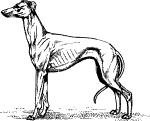 Teaching your dog to be gentle is essentially the same thing as teaching bite inhibition. Dogs should learn that people have very sensitive skin, and that they should be very careful with their teeth. This is a process that starts when they are puppies with their littermates. When a pup bites another puppy too hard, the puppy squeals and runs away. The pup who bit too hard learns that the fun stops when she bites too hard. Teaching a puppy to be gentle is a continuation of this. Obviously, with a deaf dog, squealing won't help, but withdrawing attention will. Teaching this should be a gradual process. Start out by pulling your hands back and getting up when the dog bites too hard (don't define too hard as any touch, that comes later). Don't pull your hands away too quickly, as that can become a game. If your pup tries to follow you, tie her to something before starting this lesson. As your pup learns, gradually make the "ouch" point lower, until your dog understands that teeth on human skin are a bad thing. (For more details on this process, please read Culture Clash by Jean Donaldson and/or How to Teach a New Dog Old Tricks by Ian Dunbar - see our Recommended Reading pages for more on these books.)
Teaching your dog to be gentle is essentially the same thing as teaching bite inhibition. Dogs should learn that people have very sensitive skin, and that they should be very careful with their teeth. This is a process that starts when they are puppies with their littermates. When a pup bites another puppy too hard, the puppy squeals and runs away. The pup who bit too hard learns that the fun stops when she bites too hard. Teaching a puppy to be gentle is a continuation of this. Obviously, with a deaf dog, squealing won't help, but withdrawing attention will. Teaching this should be a gradual process. Start out by pulling your hands back and getting up when the dog bites too hard (don't define too hard as any touch, that comes later). Don't pull your hands away too quickly, as that can become a game. If your pup tries to follow you, tie her to something before starting this lesson. As your pup learns, gradually make the "ouch" point lower, until your dog understands that teeth on human skin are a bad thing. (For more details on this process, please read Culture Clash by Jean Donaldson and/or How to Teach a New Dog Old Tricks by Ian Dunbar - see our Recommended Reading pages for more on these books.)
Teaching "Sit"
Rambunctious, rumbustious, delinquent dogs become angelic when sitting.
- Ian Dunbar
 Sit is probably one of the most basic things that any dog is taught (and probably one of the easiest too). Start out by holding a treat at your dog's nose, and then draw it back toward his ears until he sits. Be careful not to raise your hand, or your dog will probably jump for the treat instead of sitting. Practice this a few times, and then start to work in the hand sign. You can use the obedience sign (at left), or you can use the ASL sign for "Sit." If you use the obedience sign, place the treat between your thumb and palm while you make the sign. Once the dog knows the sign, you won't need the treats in your hand.
Sit is probably one of the most basic things that any dog is taught (and probably one of the easiest too). Start out by holding a treat at your dog's nose, and then draw it back toward his ears until he sits. Be careful not to raise your hand, or your dog will probably jump for the treat instead of sitting. Practice this a few times, and then start to work in the hand sign. You can use the obedience sign (at left), or you can use the ASL sign for "Sit." If you use the obedience sign, place the treat between your thumb and palm while you make the sign. Once the dog knows the sign, you won't need the treats in your hand.
Teaching "Down"
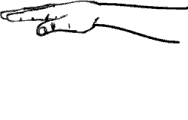 Down is another very basic command, but it is sometimes a bit harder to teach. The usual way to teach it is to have the dog sit, and then lower a treat from the dog's nose to the floor. Be careful that you are not moving the treat forward, as sometimes the dog will stand up (with her head down) to get the treat. This gesture will naturally turn into a down sign, but you can also use the ASL "Down."
Down is another very basic command, but it is sometimes a bit harder to teach. The usual way to teach it is to have the dog sit, and then lower a treat from the dog's nose to the floor. Be careful that you are not moving the treat forward, as sometimes the dog will stand up (with her head down) to get the treat. This gesture will naturally turn into a down sign, but you can also use the ASL "Down."
Some dogs simply will not lie down this easily. Another way to do it is to sit or squat on the floor with one leg in front of you. Pick up a treat, and reach under your leg to show it to the dog. Lead her under your leg, which should be low enough that she must lie down to fit. As soon as her elbows and belly are on the floor, sign "down" and give her the treat. She should figure it out fairly quickly so you won't need to be on the floor very long. You can also use this method with a low table or under a chair.
Another way is slower, but will still work. Hold a treat in front of the dog's nose, and lower it a few inches (enough that she lowers her head). Be sure that her tail stays on the floor, don't give the treat for standing (you can hold the treat between your thumb and palm, so that your hand is in the "down" hand position). Once she is doing this regularly, lower it more. When she will lower her head all the way to the floor, start to draw the treat forward (just a smidge at a time). Again, be sure that her tail stays down. Your dog will eventually move a paw forward, so quickly give her a treat. Keep luring further and further along, until your dog will lie down. This may take a few lessons, but you will get there.
Return to indexTeaching "Stand"
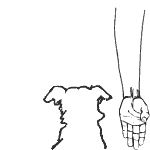 Stand is not a command that is used a lot, but it can come in handy when brushing your dog, or at the vet's office. With the dog sitting, lure him into a stand by passing a treat in front of his face. Most dogs will get up to get the treat. Give him the treat, and then put one hand in his collar and the other under his belly (so that he must stay standing). Just hold him a few seconds, then release. As he gets used to this, extend the time, and touch him all over (including tail, toes, mouth, and ears). Give more treats if necessary. The idea is that the dog will stand comfortably, no matter what you are doing to him. The sign will start out going from the dog's nose forward, but should be gradually angled upward (it will be a sweeping straight arm motion up), so that the dog will just stand instead of walking forward to get the treat.
Stand is not a command that is used a lot, but it can come in handy when brushing your dog, or at the vet's office. With the dog sitting, lure him into a stand by passing a treat in front of his face. Most dogs will get up to get the treat. Give him the treat, and then put one hand in his collar and the other under his belly (so that he must stay standing). Just hold him a few seconds, then release. As he gets used to this, extend the time, and touch him all over (including tail, toes, mouth, and ears). Give more treats if necessary. The idea is that the dog will stand comfortably, no matter what you are doing to him. The sign will start out going from the dog's nose forward, but should be gradually angled upward (it will be a sweeping straight arm motion up), so that the dog will just stand instead of walking forward to get the treat.
Teaching "Stay"
 Stay is an exercise that teaches the dog self control. Have the dog sit, and sign "stay" (your hand held palm in front of her face, or the ASL "Stay" which uses both hands). Quickly give a treat, then sign "Stay" again, another treat, "Stay" and one more treat. Then an enthusiastic "OK!" and she's done (you want her to change postition when you release her). Gradually make the time between the treats a bit longer, so she will stay sitting for longer periods of time (still use 3 treats, and then an "OK" when she is done working). Once she seems to understand, move on to the next step. Place the 3 treats on the floor in front of her. While she is still, feed her one treat at a time, fairly quickly (don't ask for the same length of time you had before, this is a new exercise for her). You may need to hold her collar at first, but don't try to hold her in a sitting position. If she insists on getting up, just do not let her have the treats. Scoop them up, cover them with your hand, or step on them. Tell her to sit again, and replace the treats. As she starts to understand that moving means the treats go away, start to stretch out the time between each bite again. Gradually add some distance (keeping the treats near you, pick each one up and bring it to the dog). Do not try to do distance and duration at the same time. If you want her to stay longer, you stay close. If you want her to stay with you further away, keep it short. Be sure to use your release sign, so that she knows when she can move. As your dog gets better, add in distractions (like jumping or spinning, or tossing toys). Staying while down is taught the same way.
Stay is an exercise that teaches the dog self control. Have the dog sit, and sign "stay" (your hand held palm in front of her face, or the ASL "Stay" which uses both hands). Quickly give a treat, then sign "Stay" again, another treat, "Stay" and one more treat. Then an enthusiastic "OK!" and she's done (you want her to change postition when you release her). Gradually make the time between the treats a bit longer, so she will stay sitting for longer periods of time (still use 3 treats, and then an "OK" when she is done working). Once she seems to understand, move on to the next step. Place the 3 treats on the floor in front of her. While she is still, feed her one treat at a time, fairly quickly (don't ask for the same length of time you had before, this is a new exercise for her). You may need to hold her collar at first, but don't try to hold her in a sitting position. If she insists on getting up, just do not let her have the treats. Scoop them up, cover them with your hand, or step on them. Tell her to sit again, and replace the treats. As she starts to understand that moving means the treats go away, start to stretch out the time between each bite again. Gradually add some distance (keeping the treats near you, pick each one up and bring it to the dog). Do not try to do distance and duration at the same time. If you want her to stay longer, you stay close. If you want her to stay with you further away, keep it short. Be sure to use your release sign, so that she knows when she can move. As your dog gets better, add in distractions (like jumping or spinning, or tossing toys). Staying while down is taught the same way.
Teaching "Leave It"
"Leave It" is a way to tell your dog that he cannot have whatever it is he is looking at. To teach it, hold a treat in one hand, open palm (if you sign your release word with your right hand, hold the treat in your left, and visa versa). Sign "leave it", and when the dog tries to take the treat, close your hand and turn it over. Do not pull your hand away or raise it up high. The dog will probably nose or lick your hand, or maybe paw at it. When he gives up and turns away, even for a second, sign "OK" and let him have it (still don't move your hand either forward or back or lower). As you practice, your dog will realize that he cannot have the treat unless you tell him that he can. Eventually, you will be able to hold a treat right under his nose and he will not touch it. Once he knows that, you can sign "leave it" regarding other things as well (such as food on a coffee table). You will need to practice, starting slow (such as putting food on the floor, then on a table, and so on), but this behavior usually transfers well.
Return to indexTeaching "Come" & "C'mere"
The most important thing to remember about teaching come, is that you must never, ever punish your dog when she comes to you. This includes giving baths, or trimming nails, or anything else that your dog does not like! No matter what she did just before you called, the only thing that she will remember is that she came, and you yelled. If your dog is misbehaving, or you need to do something unpleasant, you must go to her. You don't want your dog to wonder whether or not it's safe to come this time. Also, when teaching "come," do not give your dog the opportunity to be wrong. In other words, don't call her to come unless you are certain that she will. Once she knows it down pat, you won't have to worry, but until that time, go get her instead of calling. Teaching a reliable come takes time (some trainers suggest that it's impossible to have a reliable recall until the dog is at least 2 years old).
 That said, teaching come is much like teaching anything else. Usually, you will end up with two forms of come. The first is an informal "c'mere" that you would use when the dog is close to you. The ASL sign for "Come" works well for this. The other is a big sweeping gesture used when the dog is further away from you (sometimes this is done over your head, to really get her attention).
That said, teaching come is much like teaching anything else. Usually, you will end up with two forms of come. The first is an informal "c'mere" that you would use when the dog is close to you. The ASL sign for "Come" works well for this. The other is a big sweeping gesture used when the dog is further away from you (sometimes this is done over your head, to really get her attention).
C'mere is a very casual come. It is optional for the dog, and is used when you don't really care if the dog comes or not (if you are going from the kitchen to the bedroom for instance, or outside, or inviting the dog over for petting). You don't need to give treats for this, since tagging along or getting her belly rubbed is usually reward enough (and it's optional anyway).
While teaching a serious "Come," especially with an older dog who may not have had good experiences previous to this, it is probably a good idea to use a line on the dog's collar. Never leave this on the dog when you aren't there to supervise! It can be pretty short in the house (4 to 6 feet), and longer for outside (20 feet is probably plenty). Do not use this line to pull the dog to you! Arm yourself with some pretty good treats, and encourage your dog to come to you (if she's a little slow, turn around and run the other way, she'll speed up to catch you). When she gets there, step on the line (quickly), so that she can't run off again, give her the treat, and then take her collar. Don't pick up the line until last. Praise her, and let her go play again. (If your dog thinks you only call her to make her come in from playing, she won't want to come either.) Practice this at least 3 times each training session. Eventually, you will be able to leave the line off, because coming to you is the most wonderful thing she could do!
Return to indexTeaching "Go" and "Move"
Go and Move are very similar, but slightly different. "Go" means the dog should move to a specific place, or in a certain direction. "Move" means simply to get out of the way, or leave the immediate area.
To teach "Go," start out with your dog sitting next to you. Tell him to "Stay," and then walk over and put a treat on the floor a short distance away. Come back to your dog, and sign "Go" (pointing at the treat will work too). He should go get the treat. After practicing this a few times, put treats in two or three small containers (35mm film canisters work well). Have your dog sit and stay again. Place the treats in different places. Direct your dog to one of them. If he goes to it, quickly give him a treat (either from your hand or open the container). If he goes to the wrong thing, give a mild no (shake your head) and take him back to where you started to try again. Once he understands that he must go where you tell him, hide the containers. You want him to go where you say, whether there is food visible or not.
To teach move, sign "Move" to your dog, and then shuffle your feet toward him. He should scoot out of the way. Do not try to run your dog down, just get him to move. When he does, sign "good dog," give him a treat, and then work on something else for a few minutes before trying it again. After a few times, he should understand that "move" means to get out of your way.
Return to indexTeaching to "Walk Nice"
Dogs are taught (unintentionally) to pull on the leash. Whenever they are taken for a walk, they pull, and their person follows along behind, so the dog think that is what a walk is. It is easier to teach a puppy with no bad habits how to walk nice, but an older dog can be taught too.
Teaching your dog to walk nice on a leash is often easier to start training off leash first. Start with a handful of treats, and while out playing, reward your dog every time she walks next to you. As she starts to do it more often, introduce a sign (such as patting your leg or hip). Once she seems to be doing well at that part, introduce walking on the leash. After she will walk nice in the back yard, try walking on the sidewalk.
Dogs that have already learned to be very determined pullers can be controlled by using a head halter (such as the Gentle Leader). There are several manufacturers, but all work basically the same way. The principal is the same as a horse halter; when the dog pulls, her head is turned and her body must follow. A small person is able to walk a large strong dog using one of these. Your best bet is to find a trainer to help you learn how to fit and use them, as most dogs will object at first (much like they did when first introduced to a leash and collar). Some dogs will not adjust, and something else will need to be tried, but most will get used to it. The only real drawback is that a lot of people will think that your dog is wearing a muzzle (in spite of the fact that the loop is not around her nose and her mouth is open with her tongue hanging out).
There are many other ways to teach a dog not to pull. Two of the most common are to stop moving whenever your dog pulls (eventually, she will come back to see why you aren't moving), or to turn and go the other way when your dog pulls (better stick close so as not to get lost). Sometimes your best bet is to talk to a trainer for help, as some techniques really need to be demonstrated to be effective. Regardless, your dog can be taught to walk nicely, it just takes practice. (Diamonds In The Ruff has a very good article on teaching your dog to "walk nice")
Return to indexGoing Further (Tricks, Vocabulary)
The first rule in successful dog training is to be smarter than the dog. Which is why some breeds are easier to train than others.
- Author Unknown
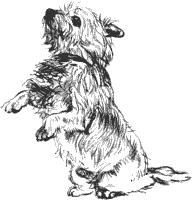 Don't stop here! the more you teach, the easier it is to teach your dog more. There are many, many things that you can teach your dog, and the more the two of you learn together, the closer the bond between you. You can teach your dog the names of various things (ball, toy, bone), or the names of family members. If you want to show off, check out our list of Activities that you can do together. Some dogs really have a lot of fun learning tricks as well (such as shake hands, speak, or roll over). The only limit is your imagination.
Don't stop here! the more you teach, the easier it is to teach your dog more. There are many, many things that you can teach your dog, and the more the two of you learn together, the closer the bond between you. You can teach your dog the names of various things (ball, toy, bone), or the names of family members. If you want to show off, check out our list of Activities that you can do together. Some dogs really have a lot of fun learning tricks as well (such as shake hands, speak, or roll over). The only limit is your imagination.
| Home | | | FAQs | | | | | Resources | | | Rescue | | | You Can Help |
© Copyright DDEAF, 1998-2024